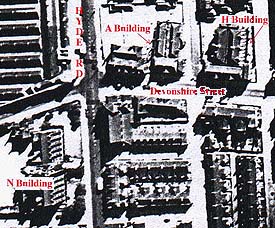|
Page One 
The three buildings were regarded by the Authority as being sufficiently close to each other for the school to be regarded as one unit and not a "linked" school, although the busy Hyde Road decisively separated Junior from Senior School. It had been assumed that both schools would be virtually self contained. In fact, classes and staff had to move across the road for special reasons-Games and P.E., Laboratory facilities, and Art and Craft facilities. Commuting across the road in all weathers was a problem, and some staff opted to move classes in order to use certain accommodation. Previous to 1967, "H" Building had always been over-crowded. Now, there was sufficient space for further developments. One of these was the establishment by the Sixth Form of its own Centre in that building. During the holiday, several Sixth formers, led by Mr. G. J. Davies, now Sixth Form Tutor, begged and borrowed surplus items of furniture and set up a centre in what had previously been Rooms 1 and 2. It was not ultra modern, but it gave a good starting point. They had their own library in the former Technical High School library, because the Senior School library was established in the library in "A" Building. The main School Office was in "N" Building to the right of the entrance foyer, which was in turn approached from Hyde Road through massive iron gates, a broad, steep flight of steps and an imposing doorway arch. The Headmaster's room was a lofty, spacious one across the entrance foyer. He also retained his room in "H" Building, and one of the adjacent rooms in that suite continued as a subsidiary office. By the end of 1966, Mr. Woodhead had been appointed Headmaster of the new school with Mr. Roberts as Deputy and Head of the Junior School, thus retaining his association with Nicholls, with his base in a room at the top of the main staircase, next door to the Staff room. Miss Irlam was appointed Senior Mistress and occupied the former staffroom in "A" Building. Mr. Martin became Head of the Senior School, using the other small room adjacent to the Head's room in "H" Building. For administration purposes, the traditional form system was used, with each year group under the control of a Year Tutor and Deputy Tutor for purposes of pastoral care, welfare and discipline. Each tutor had a room from which to work. Twice a week (Mondays and Fridays) Junior and Senior School assemblies were held. Year assemblies were on Wednesdays, with separate assemblies for boys and girls in both schools on Tuesdays. Each form had its assembly in the form room on Thursdays. Responsibility for taking assemblies was arranged on a rota basis from among those staff, including the Headmaster, most directly concerned. Dinner tickets were sold or distributed by the office staff at breaktime on Monday mornings. After this time, tickets had to be obtained from the appropriate office at specific times. School hours were fixed at 9:00 to 12:30 and 1:40 to 3:45, with a 7 period day, although later these were changed to allow for an earlier start, a shorter dinner hour and an earlier finish. Although each of the three schools had used a system of record cards for pupils, it was decided to use a folder system, with a folder for each boy or girl, into which went all records, details and correspondence. These folders were available in the Year Tutor's room. The School motto was "Salvo officio" and school colours were black, silver and lime green, with the black blazer having a badge which incorporated the emblems of the three schools-torch, castle tower and fleur de Iys. Ties, grey or black trousers, grey pullovers, white blouses and grey skirts for girls were the main other uniform items, and any departures from these standards were strongly discouraged. Grants continued to be available to parents, although later the Education Committee altered the system so that the grants were available in the form of vouchers and could be used for more general school clothing purposes.
|
